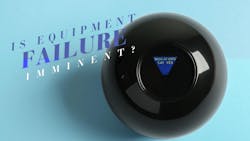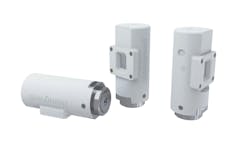Good Vibration Monitoring Predicts and Prevents Equipment Failures
Key Takeaways
- Early Detection Saves Millions — Vibration monitoring can detect issues that would normally go unnoticed, potentially avoiding millions in equipment failure costs and unplanned downtime.
- Holistic Monitoring Beyond Vibration — Modern condition monitoring systems integrate multiple sensors (temperature, humidity, pressure, acoustics) to provide comprehensive asset health insights and optimize both equipment performance and process conditions.
- No Retrofit Required for Most Applications — Predictive maintenance solutions typically work with existing plant sensors, making implementation cost-effective and scalable from single plants to enterprise-wide deployments.
Most of us don’t have precognition. We don’t have visions of the future, and we can’t always anticipate what happens next. But we do have access to something similar: condition monitoring.
“Essentially, condition monitoring technologies are all about identifying a potential failure as early as possible. The extra time gained allows for more planned corrective action, to research and diagnose these issues and to prepare and optimize a remediation plan,” says Sean Gregerson, vice president of asset performance management, Aveva, Chicago, who has over 20 years’ experience with artificial intelligence (AI) and machine learning and their role in the health of industrial assets.
Progressing from “Ok, I’ve got a problem” to understanding the root cause and appropriate actions is a valuable trick to have.
“That’s why we see in industry today vibration monitoring technology largely winning out as the more broadly applied technology for online condition monitoring,” he explained.
“It might not provide warnings as early as shock pulse analysis or ultrasonic analysis could, but what you are getting is a more comprehensive understanding of overall machine health. Shaft misalignment, imbalance issues, gearbox issues – issues that aren’t just associated with the bearing itself. It provides a broader utility.”
Having said that, it is a toolbox, and some condition-based monitoring technologies work better in certain situations. Ultrasonic monitoring can be more effective than vibration monitoring for slow-rotating assets, for instance.
Ensure Data Quality
Of course, any data-reliant technology is subject to the “rubbish in, rubbish out” adage. Gregerson notes that a multi-tiered approach is needed to ensure data quality.
This, he says, starts with the predictive model templates the company has for a very wide spectrum of the assets seen in industry today. Twenty years and 22,000 manhours have been spent developing its fault diagnostic and prescriptive guidance library: “So we understand what sensors should go into the predictive models, what the failure modes are for that asset, what the prescriptive guidance is and what action should be taken.”
Aveva also has built-in tools to cleanse the data used to train the models. These, for example, detect outlier conditions that should not be part of the overall model data training set.
“We also have sensor issues and failure detection because often, you find when you start to deploy these programs at scale that sensor issues can become quite common, whether it’s improperly calibrated sensors or sensor failure. So, we have an entire front end to the application that is managing these sensor-related issues,” he added.
Another benefit of the technology is that it scales up and down extremely well. “The problem that we are solving with this predictive analytics and predictive maintenance approach is just as meaningful for a small single plant as it is for a large enterprise with hundreds of facilities, because the reliability of the asset is directly affecting the profitability of the business.”
Taking this approach, taking the time to improve the reliability of your industrial assets, is important. “The great thing with this AI-driven software approach is that it starts with the existing sensors that are already deployed and available for the asset, so in most cases, there is no need for a retrofit to get value from the solution,” Gregerson added.
It’s also worth remembering, he says, that a lot of this technology has been available for many years.
“It’s just that having these new AI capabilities allows us to go further into things like more prescriptive guidance and increased fault diagnostic capabilities. As sensors get more sophisticated, the AI grows in sophistication, too, and so the guidance we can offer gets more refined,” he concluded (Figure 1).
Chemical Industry Vibration Issues
According to Bubathi Muruganantham, application engineering manager, process measurement and control, Honeywell, India, the chemical industry is prone to particular asset-specific challenges, including bearing issues in motors, noise with centrifugal pumps, shaft issues in agitators and misalignments in blowers.
This was a persistent problem for a fertilizer manufacturing company with no routine condition monitoring, relying solely on the annual shutdown to detect problems. Even then, a third-party vendor carried out manual vibration measurement and diagnosis.
“We installed Honeywell Equipment Health Monitoring, which the customer used to automate data collection from its assets, for early fault detection in order to plan maintenance work, and cost avoidance in secondary damage,” said Muruganantham.
Another example, cited by Andrew Brodie, chief product officer, process measurement and control, Honeywell, Houston, highlights the holistic aspect of monitoring machine health.
Here, a company specializing in coatings and paints needed strict temperature and humidity during its process, or the products wouldn’t adhere properly.
“Our Versatilis Equipment Health Monitoring device contains multiple sensors. It’s primarily a vibration sensor, but also has acoustics, ambient and surface temperature, air pressure and humidity. In this case, the customer was mainly interested in the temperature and humidity data so that its process could be optimized,” explained Brodie (Figure 2).
Sometimes, he points out, the time-of-use information is key. “If you’ve got a large air compressor running only one or two shifts, it shouldn’t be running at night unless there’s an issue around leakage in the air system. So, it’s having to run at night to make up for lost air. You are wasting energy.”
In another example, a customer was unaware until vibration condition monitoring equipment was installed that an item was starting up and shutting down at irregular intervals.
“Once again, you’re measuring equipment health, but the derivative of that is you also know when the equipment is running. You may also know when it shouldn’t be running. Do you have a case of a phantom shift, for example?” asked Brodie.
Such ancillary findings aren’t unusual. Brodie cites the case of another customer, an equipment manufacturer, that was looking for a way to apportion energy use as part of a supply contract. While vibration was a proxy for a compressor running — i.e., major energy consumption—the time of activity found in the data set had other implications.
The company found that one of the 12 work cells being monitored consistently started 15 minutes later than the others.
“Why is that? Is there a problem with that particular work cell? Is it a training issue? Was that employee slow to return from lunch on a regular basis, perhaps? This is what you begin to see with the correlation of data and time. So that was a sort of side benefit that popped out of it. It wasn’t something they were looking for; they were more focused on the amount of energy consumption,” he explained.
The same is true for capital equipment that could be on site, such as earthmovers. Are they being used on a weekend, for example, when nobody is supposed to be using them?
Honeywell is currently in the proof-of-concept stage on a similar piece of capital equipment, he added.
Points to Consider in Vibration Monitoring
Even so, Muruganantham cautions that process engineers need to think about important factors when considering vibration monitoring.
One is that the source of vibration can be the machine, or it can be the process. Once a plant has the process data, it is essential to understand, for example, the pump. Is it running according to the best efficiency point? Or is there any process condition that is beyond a prescribed limit?
“Improper maintenance can also lead to vibration issues. So, following the correct guidelines from the OEM regarding maintenance is important – it could simply mean using the correct grease or oil, for example,” he said.
Second, it’s important to have a good detection system to help you understand the source of the vibration. The critical things are the maximum vibration frequency (Fmax) and the mounting, because the resonant frequency will change depending on these. If the vibration frequency matches the resonant frequency, incorrect readings will be seen.
“Of course, you need to get the right data before it can be analyzed,” Muruganantham added.
The point is that the more combinations of bearing faults and their curated causes, the stronger the data gets over time.
Honeywell’s asset performance management team is currently working to integrate 15 years’ worth of vibration sensor data into its technologies.
“That’s where AI analysis of the data comes in. This is the stuff that allies itself very well to AI when you have enough data sets collected, enough correlations between the equipment monitored and the signals they are producing,” said Brodie.
It’s good for small businesses, too, as the accessibility of AI drives down the cost of analysis and troubleshooting.”
Condition Monitoring’s Future
So, what’s coming down the condition monitoring pipeline?
Muruganantham points to many areas ripe for improvement, including sensor power, edge processing, insight generation and machine-enabled service. Batteries will be redundant as more devices make use of energy harvesting. Plant equipment will have intelligent sensors to detect issues.
“Generative AI will have more impact on data insight and the maintenance process,” he explains. In the case of condition monitoring, you will get a probable cause based on previous records and actions that need to be completed, and not necessarily by skilled staff.” ⊕
About the Author
Seán Ottewell
Editor-at-Large
Seán Crevan Ottewell is Chemical Processing's Editor-at-Large. Seán earned his bachelor's of science degree in biochemistry at the University of Warwick and his master's in radiation biochemistry at the University of London. He served as Science Officer with the UK Department of Environment’s Chernobyl Monitoring Unit’s Food Science Radiation Unit, London. His editorial background includes assistant editor, news editor and then editor of The Chemical Engineer, the Institution of Chemical Engineers’ twice monthly technical journal. Prior to joining Chemical Processing in 2012 he was editor of European Chemical Engineer, European Process Engineer, International Power Engineer, and European Laboratory Scientist, with Setform Limited, London.
He is based in East Mayo, Republic of Ireland, where he and his wife Suzi (a maths, biology and chemistry teacher) host guests from all over the world at their holiday cottage in East Mayo.



